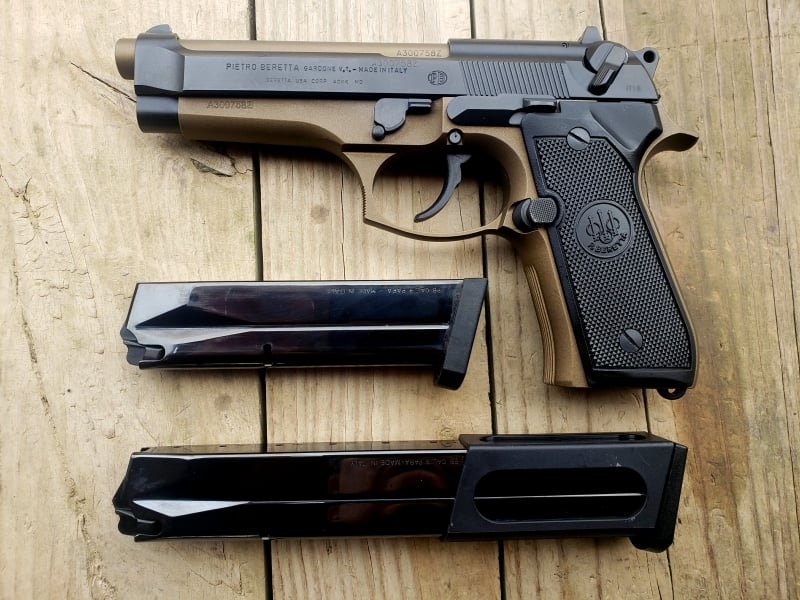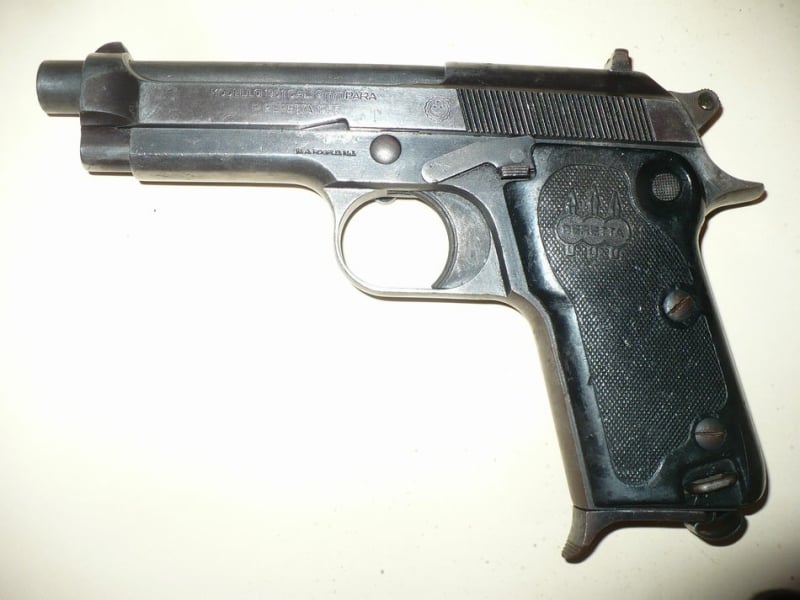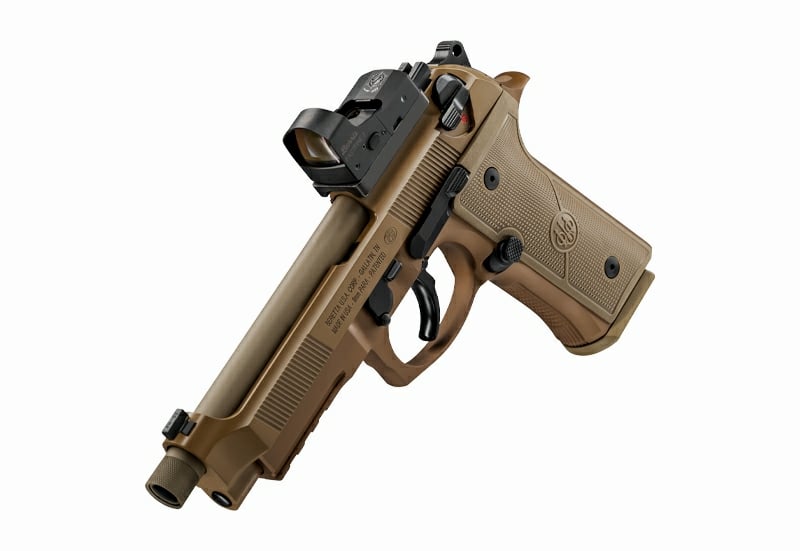The Beretta 92 pistol is among the most popular and iconic handguns ever produced. The gun’s excellent design and track record combined with Hollywood, the US military, and just plain good looks elevate the Model 92 Series to a status few firearms ever achieve. Despite being introduced nearly a half century ago, the handgun is still going strong, with Beretta having produced an estimated 3.5 million Model 92s across the entire series.

Building on Older Designs
Beretta began production on the Model 92 in 1976, but the design was not all original. The Model 92 took elements from earlier Beretta pistols, as well as from a competitor. The familiar open slide was first implemented on the Beretta M1923 pistol, while the alloy frame came from the Beretta M1951, sometimes called merely the “951.” The falling block locking system came from the Walther P38, which also featured an open slide.
Despite not being original, those were all solid design choices. The open slide reduces weight and all but eliminates stovepipe malfunctions. The alloy frame makes the gun even lighter, without sacrificing strength in the 9mm chambering. Finally, the falling block locking system is extremely effective and reliable, contributing to the Model 92’s reputation for being a very safe handgun. The original Beretta Model 92 also featured a 1911-style frame-mounted safety catch, which was soon discarded for a P38-like slide-mounted decocker/safety lever. That mechanism has been further updated through the years, as we will see.

Police and Military Updates
The safety mechanism was originally changed as law enforcement agencies began adopting the Model 92. The requested change prompted the Model 92S, the first to fully incorporate the new slide-mounted decocker/safety.
Military interest in the late 1970s and early 1980s led to the Model 92SB, featuring an ambidextrous safety/decocker lever, firing pin block, and 3-dot sights. The 92SB also changed the original European-style heel magazine release to the more familiar button release we know today. A smaller version, the Model 92SB Compact, was produced from 1981 to 1991. The 92SB Compact had a shorter barrel and slide and a 13-round capacity.
Beretta’s big break came in 1984 when its new Model 92F entered and won the competition to replace the US military’s aging Colt M1911 pistols. The 92F became the basis for modern Model 92 variants like the 92FS, 92G, 92X, and M9 series. The new 92F standardized all parts for easy maintenance and logistical support, squared off the front of the trigger guard, enhanced the grip, implemented a chrome-lined barrel, and introduced the new corrosion-resistant Bruniton finish instead of the old bluing.
The military designated the new service pistol as the M9, and Beretta released the civilian 92FS, which updated the 92F with slight internal tweaks. The M9’s 1985 adoption saw explosive growth not only on the government service side, but also in law enforcement and new civilian sales.

Hollywood Adopts the Beretta 92
Hollywood rarely knows anything about guns, but the mid-to-late 1980s saw the Model 92F explode on the big screen. Being a fledgling gun nut about that time, I first recall becoming enamored of the Model 92 when I saw Mel Gibson, as Detective Martin Riggs, wield the 92F in 1987’s “Lethal Weapon.” I was certain I had never seen a cooler handgun in my life.
I remember scheming over the latest issues of “The Shotgun News,” trying to figure out a way to buy one on my meager wages. I haunted gun shows looking for one on sale. I even contemplated buying a knock-off Taurus 92 as a cheaper substitute, but never did. But being a poor dude in his early twenties who soon had a kid on the way, I never got one. I had to wait until my more prosperous later adulthood to purchase a Model 92FS, of which I now own two. But I still credit Mel Gibson for my ongoing love for the Model 92.
But an even bigger movie boost came around the next year, when New York cop John McClane, played by Bruce Willis, took on the terrorists at Nakatomi Plaza in the greatest Christmas movie ever, “Die Hard.” McClane’s sidearm was the very same Beretta 92F carried by Riggs in “Lethal Weapon.” Not the same model, but the exact same gun. Call it Hollywood recycling, I guess, but I just think it’s awesome. That fully functioning 92F is now in a museum, as it should be. In a perfect world, it would have a plaque reading, “In Case of Terrorists, Break Glass,” and several full magazines would magically appear.
Since Riggs and McClane, the Model 92 has appeared in countless movies, including one of my favorite vigilante films, “The Boondock Saints” (seriously, those guys should be in every major city). From the 1980s until today, if a movie has handguns, there’s a good chance at least one of them will be a Beretta 92.

Model 92 G, D, and the Model 96
Law enforcement agencies moving from revolvers to semiautomatic pistols requested that Beretta change the safety/decocker mechanism to a decocker-only affair. They felt that would ease the transition for cops accustomed to a double-action first shot with no safety mechanism. The result was the Model 92G, in which the lever is the same, but only functions as a decocker, immediately reverting to “fire” mode when activated.
The Model 92D is a double-action-only version that entirely lacks the safety/decocker lever, relying on the double-action pull itself. The 92D also included a lighter hammer spring that eased the double-action pull. The 92D was not a commercial success, unlike the 92G, but the lighter hammer spring is now available as an upgrade to other models, as is the 92G decocker mechanism.
I upgraded one of my 92FS guns with the 92D hammer spring and 92G decocker, getting the best of both worlds. That gun also sports a Wilson Combat enhanced mag release, which is a big improvement over the factory release button. My other, more recently acquired 92FS will soon get the same treatment.
The Model 96, which is essentially a sub-series of the 92, features pistols chambered in .40 Smith & Wesson. The 96 series pistols came about as American law enforcement agencies transitioned to the .40 S&W cartridge. The frame and slide were beefed up to handle the hotter loads. With .40 S&W on the decline, demand for the Model 96 has waned. But Beretta did the Model 96 right by making accessories, such as the 92G decocker, compatible with 92 and 96 pistols.
US Military Evolution
Military use led to new editions like 2005’s M9A1, which introduced a beveled magazine well, aggressive front and backstrap checkering, and an accessory rail. 2015’s M9A3 (the M9A2 was never really a thing) took the civilian Model 92 Vertec pistol’s removable front sights and slimmer backstrap. The new backstrap was aimed at helping shooters with smaller hands reach the trigger more comfortably, which had long been a criticism of the Model 92 design. The M9A3 did, however, include wraparound rubber grips that mimic the original grip dimensions. The M9A3 also included the 92G decocker mechanism. The US military ultimately rejected the M9A3, choosing instead to seek an entirely new pistol for the XM17 project, which eventually chose the Sig Sauer P320.

The recent M9A4, though not a US military pistol, carries on the M9 line. The M9A4 includes the Vertec grip, an optics-compatible frame, dovetailed tritium night sights, a three-slot Picatinny accessory rail, and Beretta’s new enhanced short reset Xtreme trigger system. The M9A4 also has a new 18-round flush magazine.
Other Model 92 Variants
The Beretta Model 92 has been around for a long time, not only because it’s a superior design, but because Beretta has upgraded the gun with changing demands. There are more variations than can be discussed in this article, so let’s hit briefly on the more prominent ones:
- The Brigadier – The Brigadier versions feature a heavier slide, which means less felt recoil. They also have a dovetailed front sight, along with other variant-specific enhancements. These guns have been popular with competition shooters who like the Model 92 but want increased performance. Brigadier variants include the Elite, Elite IA, Elite II, 92G-SD, and Brigadier Tactical.
- The Vertec – Besides influencing the M9A3 and M9A4, the Vertec is a nice gun on its own. Features include the slimmer grip, removable front sight, accessory rail, flared mag well, and a shorter 4.7-inch barrel, as opposed to the standard 4.9-inch barrel.
- The 92FS Compact L – The Compact L has a 4.25-inch barrel and a shorter grip. It has a 13-round capacity. “Compact” is a relative term here, since the Compact L is more akin to what we consider duty guns like standard Glocks. Originally based on the Model 92SB, the current Compact Ls are based on the 92FS. There are several Compact L variants, including the Type M (discontinued in 2004), the Custom Carry I and II, and the M9A1, which includes an accessory rail and aggressive grip checkering.
- The Model 90Two – An odd, supposedly “enhanced” Model 92 with polymer wraparound grips and a new appearance. The 90Two isn’t really prominent, but it needs to be mentioned, if only for the strangely confusing name.
- The Model 92 FSR is chambered in .22 Long Rifle, with a suppressor-ready version. There is also a .22 Long Rifle M9.
- The Model 92X – This latest Model 92 is a performance pistol that is essentially the civilian version of the M9A4. It features the Vertec grips with wraparounds, “universal” slide with F or G safety/decocker capability, beveled mag well, combat sights, three-slot Picatinny rail, and enhanced mag release. The 92X also returns to the classic rounded trigger guard. Recent variants include the Model 92X Performance Defensive, 92X Performance Carry Optic, and 92XI, with a frame mounted safety.

A Pistol for the Ages
I admit to loving the Beretta 92 series. Even 30-plus years later, I think it’s the sexiest semiauto pistol ever made, though the P08 Luger is right there. And that sexy look carries over to performance. The 92 was one of the original “Wondernines,” along with the equally excellent CZ75. Their high-performance, double-stack 9mm designs took the world by storm. Suddenly, 7 or 8+1 didn’t cut it. Six-shooters became old fashioned (though I dearly love me some revolvers).
I love my 92FS so much that I even carry it sometimes. It’s not my everyday setup, mind you. But sometimes I prefer style over comfort. And my 92FS wins the style contest over my polymer striker guns all day long. And I don’t sacrifice anything with the 15+1 or 17+1 capacity and better shootability the 92 offers. With the G Model decocker and D Model hammer spring, the first DA shot isn’t bad at all, and I don’t have to worry about the gun being on safe if I need it. Beretta even makes a 30-round mag for it. I have a couple and they’re great fun at the range.

History indicates that many people agree. Rarely is a nearly five-decade-old design not only relevant, but among the best-selling products in the world. That the Model 92 is Beretta’s flagship handgun is an understatement. It’s probably not a stretch to say it may be the company’s flagship product across all platforms.
Whether Beretta can maintain the Model 92 going forward remains to be seen. Firearms are constantly evolving. But given the design’s basic quality and its performance since 1976, are you gonna bet against it? I’m not.


